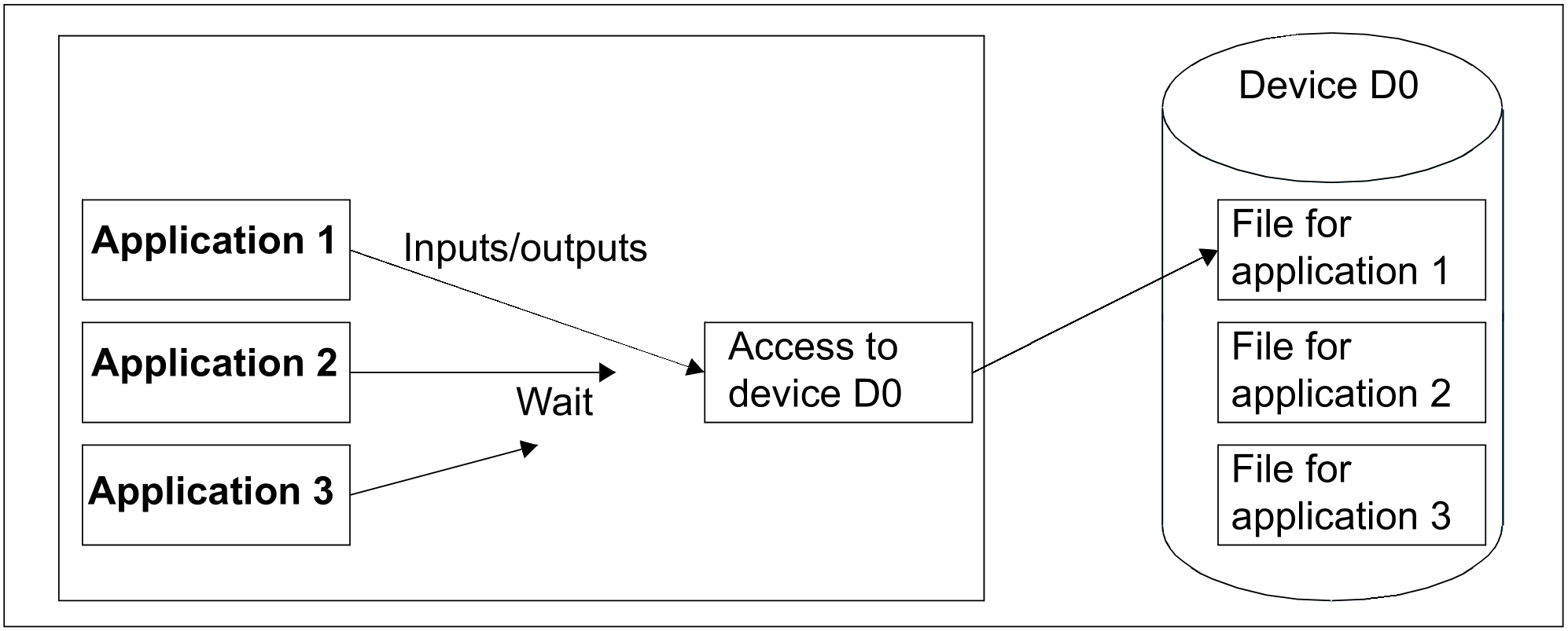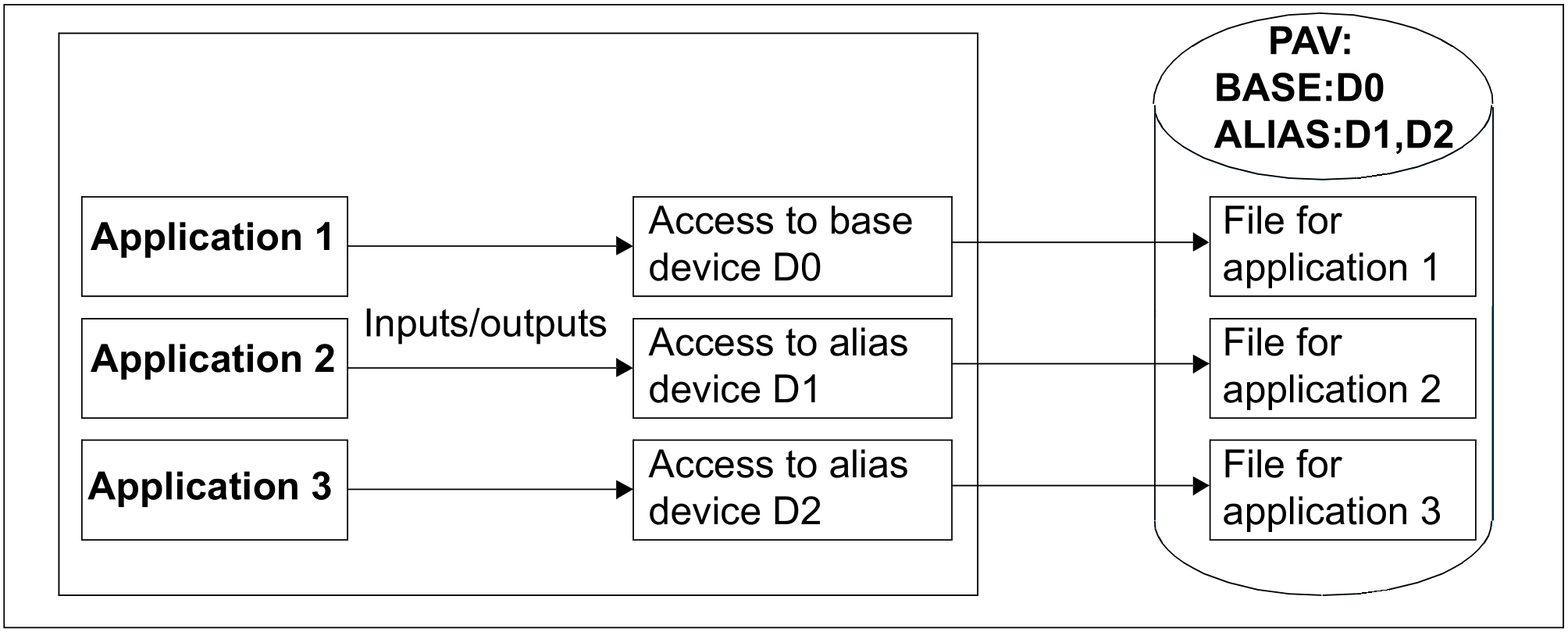Input/output requests of different applications to the same device are generally serialized. Input/output requests that come later have to wait until the previous input/output is completed. Up to now it has only been possible to improve performance in this respect by means of appropriate data organization on different data carriers.
For all disk storage systems operated via Fibre Channel, BS2000 offers the function Parallel Access Volume (PAV) which enables multiple I/Os to a disk device (a logical volume) to be performed in parallel.
| PAV devices are not available on SU x86. The inputs/outputs there are automatically parallelized by X2000. |
A PAV device consists of a real base device (BASE) with up to seven alias devices (ALIAS).
Further information on PAV is provided in the “Introduction to System Administration” [2].
(Static) PAV in native operation
PAV can be used on the channel for disk devices of the type D3435 in FBA format.
Here the PAVs are set up only when the I/O configuration data is generated (DVC statement of IOGEN). The PAV properties are detected by the operating system from the device’s generation data. Changes to the PAV structure require generation to be performed again or dynamic modification of the I/O configuration, see "Dynamic PAV in native operation".
At hardware generation (see the “System Installation” manual [1]), the base device and alias devices are generated as independent devices of the same type with the same Logical Unit Numbers but different unit addresses and mnemonic device names on the same controller.
When the base device is attached, BS2000 automatically attaches the associated alias devices. After the base and alias devices have been attached, I/Os for the PAV can be processed in parallel via base and alias devices. Device assignment in the guest system continues to apply only for the base device. I/Os are issued to the base device by the applications. The operating system controls execution via the base or alias device.
The BS2000 command /SHOW-DEVICE-CONFIGURATION INFORMATION=*PAV provides information on PAVs.
(Static) PAV in VM2000 operation
PAVs can be used in VM2000 for the monitor system and the guest systems.
The base device can be assigned to a VM explicitly or implicitly (see "Assigning and removing devices of a VM").
Alias devices are always assigned to a VM implicitly, regardless of the ASSIGN-BY-GUEST setting, if the base device is attached in the guest system. Explicit assignment of alias devices is rejected.
VMS4192).Alias devices always have the same usage mode as the associated base device. The usage mode of a base device can be changed with /MODIFY-VM-DEVICE-USAGE USAGE= *SHARED/*EXCLUSIVE (the usage mode of its alias devices thus changes as well).
For information on I/Os for shared devices, see also "Usage mode of a device".
An (implicitly or explicitly assigned) base device can be detached from a VM explicitly. In implicit release, the base device is released by the guest system (see "Assignment sets, implicit device assignment and release"). Alias devices are released automatically with the base device. Explicit removal of alias devices is rejected.
You can obtain information on PAVs in VM2000 by means of /SHOW-VM-DEVICE-STATUS. The PAV-ATTRIBUTE operand lets you control the selection of PAVs. The INFORMATION=*PAV operand displays the PAV structure for the relevant device.
In order to obtain as even distribution of I/Os for VM2000 shared disks as possible, the operating system in the guest systems prefers the base device or a special alias device. The selection is made via the VM index. Preferred base or alias devices can also be defined explicitly in each guest system by means of the BS2000 command:/MODIFY-IO-UNIT UNIT=*DEVICE(NAME=...,STATE=*PAV-PREFERRED-DEVICE(...))(see "MODIFY-IO-UNIT (Modify configuration properties of an I/O unit)").
Dynamic PAV (DPAV) in native operation
Static PAV, as described above, requires careful planning of future device utilization. When generation in BS2000 takes place, it must be borne in mind that a separate address is required for each alias device.
Dynamic PAV (the IORM function DPAV, see "Use of IORM in VM2000 operation" and the “Utility Routines” manual [3]) requires fewer alias devices. As with static PAV, alias devices must be generated, but it is not necessary to provide the maximum number of alias devices required for each volume in advance. DPAV autonomously assigns alias devices to those volumes which profit from this the most.
Dynamic PAV (DPAV) in VM2000 operation
DPAV in VM2000 requires the IORM subsystem in the monitor system.
When a bottleneck occurs for a PAV device in a guest system, the IORM subsystem in the guest system requests the IORM subsystem in the monitor system to coordinate and execute the following actions:
Search for the alias device which is utilized least.
Request all BS2000 guest systems to detach the selected alias device. The alias device is removed from the VM because an alias device is only implicitly assigned to a VM.
Assign the selected alias device to the new base device by means of a dynamic modification of the configuration (
/REMOVE-IO-UNIT,/ADD-IO-UNIT).Inform all BS2000 guest systems of the new assignment.
In this case the newly configured alias device is also attached, and consequently assigned to its own VM implicitly - in the guest systems in which the base device is attached.
For Server Units that support FastDPAV, it is no longer recommended to use DPAV.
Fast Dynamic PAV (FastDPAV) in native operation
When a bottleneck occurs for a PAV device in a guest system using DPAV, the above described actions (especially in VM2000 operation) need certain time, in which the load for PAV devices might have changed again. In order to bybass this shortcoming, an optimized DPAV ("FastDPAV") is offered for Server Units /390 that supports a modification of the logical unit number (LUN) for alias devices when starting an I/O (SU710 and later).
When using FastDPAV, a pool of FastDPAV alias devices is generated (with device typ D3435-FP, internally A6) for a set of logical volumes with identical channel paths without a permanent assignment to one of these logical volumes. For a FastDPAV alias device, the LUN is only defined/modified when an I/O is started.
Advantages of FastDPAV compared to DPAV:
- FastDPAV does not require IORM for monitoring device utilization and switchover of alias devices.
- FastDPAV requires no coordination with other systems.
- Alias devices are available immediately whenever required.
In native mode, BS2000 automatically activates all generated FastDPAV alias devices for I/O.
FastDPAV can be used with or without static PAV.
Fast Dynamic PAV (FastDPAV) in VM2000 operation
In the VM2000 mode, BS2000 activates only those generated FastDPAV alias devices that have been exclusively assigned to the VM.
VM2000 prevents from a shared assignment (usage mode SHARED) for FastDPAV alias devices.
The FastDPAV alias devices can be assigned explicitly (using /ADD-VM-DEVICES), or implicitly (using /ATTACH-DEVICE) provided the VM and the devices have the required authorization.
When performing I/O, BS2000 considers only the activated FastDPAV alias devices. You can define with BS2000 command /MODIFY-IO-OPTIONS whether base or alias devices are to be preferred for starting I/Os in the guest system.
The FastDPAV alias devices are not handled by VM2000 as conventional alias devices (PAV/DPAV), thus they are not displayed like those with command /SHOW-VM-DEVICE-STATUS either.
Example of the use of (static) PAV in VM2000
In this example a base device is assigned to the monitor system. The base device is attached and then detached again in the monitor system.
/show-vm-device-status units=*std,information=*pav,
select=*par(state=*disposable,pav-attribute=*base) ———— (1)
UNIT DEV-TYPE PAV S ASSIGN-SET USAGE VM-ID/(#VM) ASSIGNED-BY2300 STDDISK BASE ———————————————————————————————————————————————————— (2) (BASE: 2300; ALIAS: 2310,2320,2330)
2301 STDDISK BASE (BASE: 2301; ALIAS: 2311,2321,2331)2302 STDDISK BASE (BASE: 2302; ALIAS: 2312,2322,2332)2303 STDDISK BASE (BASE: 2303; ALIAS: 2313,2323,2333)2304 STDDISK BASE (BASE: 2304; ALIAS: 2314,2324,2334)2305 STDDISK BASE (BASE: 2305; ALIAS: 2315,2325,2335)... (Ausgabe gekürzt)5400 STDDISK BASE (BASE: 5400; ALIAS: 540C)/add-vm-devices units=2300,vm-id=monitor —————————————————————————————— (3)VMS4005 DEVICE '2300' ASSIGNED TO VIRTUAL MACHINE (1,MONITOR)
/show-vm-device-status units=23*,information=*pav,
select=*par(state=*assigned(vm-id=monitor)) ———— (4)
UNIT DEV-TYPE PAV S ASSIGN-SET USAGE VM-ID/(#VM) ASSIGNED-BY2300 STDDISK BASE EXCL 1 MONITOR VM-ADMIN (BASE: 2300; ALIAS: 2310,2320,2330)****** Gastsystem-Operating auf der Monitor-VM:*** /attach-device unit=2300 —————————————————————————————————————————— (5) *** NKR0042 'DEVICE =2300': ATTACH ACCEPTED*** NKR0042 'DEVICE =2300': ATTACHED*** NKR0042 'DEVICE =2310': ATTACH ACCEPTED ——————————————————————— (6) *** NKR0042 'DEVICE =2320': ATTACH ACCEPTED*** NKR0042 'DEVICE =2330': ATTACH ACCEPTED*** NKVD010 DISK 'PF1.00' MOUNTED ON DEVICE '2300'*** NBR0740 COMMAND COMPLETED 'ATTACH-DEVICE';*** (RESULT: SC2=000, SC1=000, MC=CMD0001); DATE: <date>
*** NKR0073 ALIAS DEVICE '2310' LINKED TO BASE DEVICE '2300'*** NKR0073 ALIAS DEVICE '2320' LINKED TO BASE DEVICE '2300'*** NKR0073 ALIAS DEVICE '2330' LINKED TO BASE DEVICE '2300'*** NKR0040 'DEVICE =2310' ATTACHED*** NKR0040 'DEVICE =2320' ATTACHED*** NKR0040 'DEVICE =2330' ATTACHED***% VMS4005 DEVICE '2310' ASSIGNED TO VIRTUAL MACHINE (1,MONITOR) (BY GUEST) ————————————————————————————————————————————————— (7)% VMS4005 DEVICE '2320' ASSIGNED TO VIRTUAL MACHINE (1,MONITOR) (BY GUEST)
% VMS4005 DEVICE '2330' ASSIGNED TO VIRTUAL MACHINE (1,MONITOR) (BY GUEST)/show-vm-device-status units=23*,information=*pav,
select=*par(state=*assigned(vm-id=monitor))
UNIT DEV-TYPE PAV S ASSIGN-SET USAGE VM-ID/(#VM) ASSIGNED-BY2300 D3435 BASE EXCL 1 MONITOR VM-ADMIN (BASE: 2300; ALIAS: 2310,2320,2330)2310 D3435 ALIAS EXCL 1 MONITOR GUEST ————————————— (8) (BASE: 2300; ALIAS: 2310,2320,2330)
2320 D3435 ALIAS EXCL 1 MONITOR GUEST (BASE: 2300; ALIAS: 2310,2320,2330)2330 D3435 ALIAS EXCL 1 MONITOR GUEST (BASE: 2300; ALIAS: 2310,2320,2330)/show-vm-attributes vm-id=monitor,information=*units —————————————————— (9)VM-ID UNITS
1 MONITOR ASSIGNED BY VM-ADMIN EXCL: C2,C3,V0,V1,2300,2430,2431,2432,2433 SHARED: 22F4,22F5,22F6,22F7,58F2 ASSIGNED BY GUEST EXCL: 2310,2320,2330****** Gastsystem-Operating auf der Monitor-VM:*** /detach-device unit=2300 ————————————————————————————————————————— (10)*** NKR0092 'DEVICE =2300': /DETACH-DEVICE PENDING ACCEPTED
*** NKR0045 *** 'DEVICE =2300' DETACHED ****** NBR0740 COMMAND COMPLETED 'DETACH-DEVICE';*** (RESULT: SC2=000, SC1=000, MC=CMD0001); DATE: <date>
*** NKR0074 ALIAS DEVICE '2310' UNLINKED FROM BASE DEVICE '2300' —————— (11)*** NKR0074 ALIAS DEVICE '2320' UNLINKED FROM BASE DEVICE '2300'
*** NKR0074 ALIAS DEVICE '2330' UNLINKED FROM BASE DEVICE '2300'*** NKR0045 *** 'DEVICE =2310' DETACHED ****** NKR0045 *** 'DEVICE =2320' DETACHED ****** NKR0045 *** 'DEVICE =2330' DETACHED ******% VMS4009 DEVICE '2310' REMOVED FROM VIRTUAL MACHINE (1,MONITOR) (BY GUEST) ————————————————————————————————————————————————— (12)% VMS4009 DEVICE '2320' REMOVED FROM VIRTUAL MACHINE (1,MONITOR) (BY GUEST)% VMS4009 DEVICE '2330' REMOVED FROM VIRTUAL MACHINE (1,MONITOR) (BY GUEST)/show-vm-device-status units=23*,information=*pav,
select=*par(state=*assigned(vm-id=monitor)) ———— (13)
UNIT DEV-TYPE PAV S ASSIGN-SET USAGE VM-ID/(#VM) ASSIGNED-BY2300 D3435 BASE EXCL 1 MONITOR VM-ADMIN (BASE: 2300; ALIAS: 2310,2320,2330)/remove-vm-devices units=2300,vm-id=monitor
VMS4005 DEVICE '2300' REMOVED FROM VIRTUAL MACHINE (1,MONITOR)
---------------------------------------------------------------------------------------------------------------
(1) | The VM2000 queries which base devices are free. Detailed information is to be displayed on the configuration of the PAVs (base and alias devices). |
(2) | The list of free base devices and their alias devices is output. |
(3) | The base device |
(4) | The VM2000 administrator displays all devices whose mnemonic names begin with |
(5) | The base device is attached in the monitor system. |
(6) | The alias devices are thus assigned and attached to the monitor VM implicitly. |
(7) | VM and VM2000 administrators are informed about the implicit device assignment by asynchronous messages. |
(8) | The VM2000 administrator repeats the command from (4). Now the alias devices are assigned implicitly to the monitor VM with the same usage mode. |
(9) |
|
(10) | The base device is detached again in the monitor system. |
(11) | The alias devices are thus detached implicitly and released. |
(12) | VM and VM2000 administrators are informed of the implicit device release by asynchronous messages. |
(13) | Only the base device is assigned explicitly to the monitor VM. |



